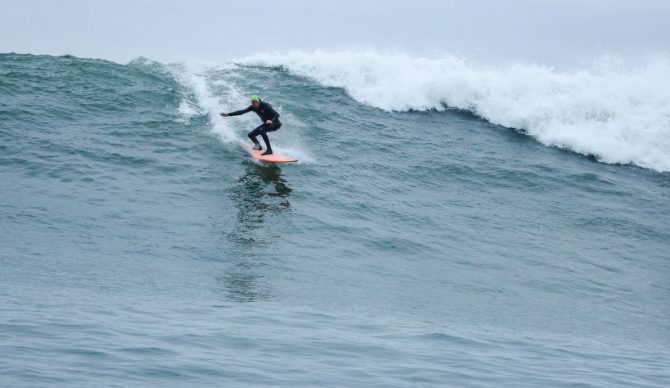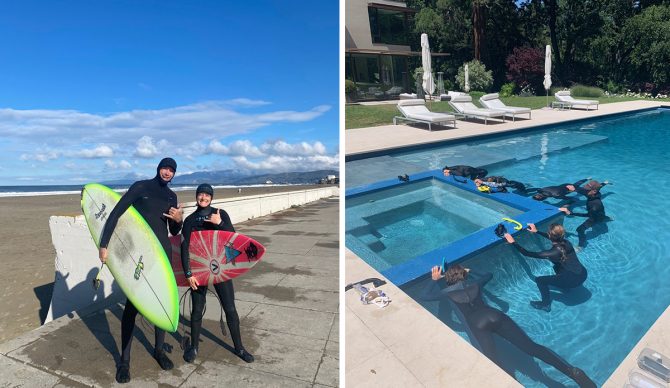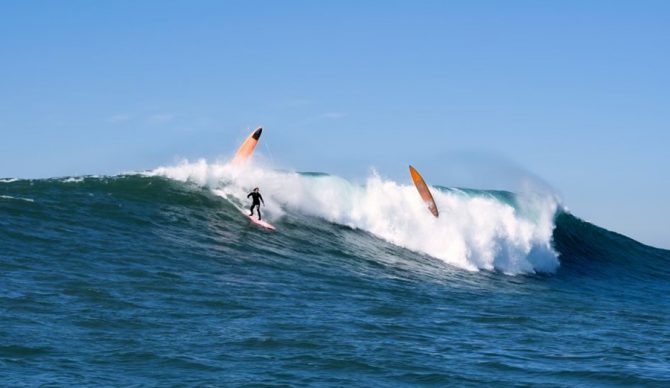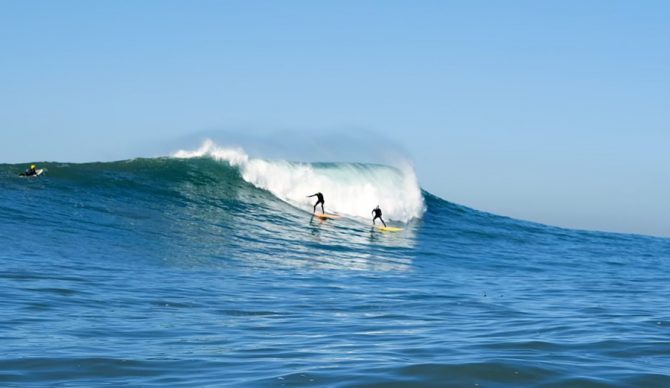
Lionel Conacher surfed Maverick’s for the first time at nearly 60 years old. His journey is as improbable as anyone else’s. Photo: Tom Hoppa
One thing nobody tells you about your first time surfing Maverick’s is how choppy it is.
It’s almost like surfing a mogul run. From your initial line of sight after the pop-up, suddenly you see an entirely different wave traveling up the 20-foot face you’re descending. There are dozens of them in every direction, while the mountain beneath you is tripling in size, the moguls are moving sideways with ledges forming up in front of you, and there is six-hundred tons of water hovering somewhere above and behind you — all before you even have a chance to dig the edge of your board into the face of the wave.
Navigating these facets and ribs make up the core project of staying on your board for a successful ride. Other jobs include managing fear, speed, balance, position, and the utterly incomprehensible thrill of surfing one of the world’s most powerful waves.
Still, all I could really manage to think was, “How come not one f**ing person ever told me about these bumps!?” That was it. I was focused on the ledges and literally nothing else.
I was not thinking about the hold-down I would endure if I made a mistake, or the legions of surfers who’ve died on this wave, or even finding my line and starting to carve. I was also unaware up there that, at 59 years and 8 months, I was about to become the oldest person in the world to surf Maverick’s for the first time.
Obviously, there are a handful of surfers older than me who ride this wave often. Yet, as far as any of us can tell, I am probably the one who started the latest.
I was even shamed online for being a 59-year-old “ultra VAL.”
This was a new term to me, albeit not the first time I’ve encountered unfamiliar slang in my 60 years. Being this old doesn’t put me in “geezer” territory just yet, but raising three now-adult children through the internet era has made me pretty good at Googling new acronyms (lol).
VAL, it turns out, isn’t easy to find. Google seems distracted by the new Top Gun movie, and the Urban Dictionary is just its usual trash-fire self. In fact, this particular phrase (with a nod to the inland, VALley surfers of California in the ’70s and ’80s) seems to be exclusive to surf culture. As it turns out, the modern VAL stands for Vulnerable Adult Learner, and it is not a kind term.

The author, with Bianca Valenti. Training meant a lot more than just surfing Maverick’s. Photos: Courtesy LC
As a slur, VAL is subtle but troubling: “vulnerable adult” is the legal designation for any adult with enough functional or mental impairment to be easily exploited or abused. As an insult, the term is only slightly warmer. It packages a little bit of the “aww” factor reserved for cute grandpas with some anger about the fact they’re taking space in the lineup. The bottom line is grommets are too young and VALs are too old.
I suspect those casually calling out VALs deserve the benefit of the doubt. It feels safe to assume they don’t mean to insult any actual vulnerable adults, and by adding L-is-for-learning, they’re probably just doing the same thing that lots of people do: thinking that they know everything.
Being this age is filled with so much wonder.
Looking back, I have to say there were many vulnerable moments in my journey to surf Maverick’s. The one that stands out most was right at the start, running down the beach as a total stranger to ask Bianca Valenti if she would coach me.

Bianca, avoiding the chaos. Photo: Ben Judkins
“Why?” she asked, and suddenly it was clear my answer to this question was going to matter much more than anything in my bank account.
The reason for my objective started out as age itself. For most of my life as a goal-oriented striver in business and the outdoors, I’ve set and achieved one audacious target for each milestone birthday. At age 50, I competed in and finished the famously grueling Leadville 100. For 40, I rode seven consecutive days of the Tour de France, and to mark my 30th, I qualified for and competed in the World Triathlon Championships. (For any of you armchair therapists, this tradition began sometime after failing to qualify for the Olympics at 20). Now, approaching my sixth decade, I decided I would like to surf the most compelling, beautiful monster I have ever seen.
Living in San Francisco, the energy of the Maverick’s wave reverberates beyond the shore and into the surf community itself. When Maverick’s is breaking, you can feel it in a conversation.
“I would never surf that wave,” more than one professional surfer has said. Sometimes it is described as “the Mount Everest of surfing,” or “the gladiators’ colosseum.” I have heard the wave described as “gnarly,” “temperamental,” “moody,” a “massive slab” of a wave, and “another wonder of the world.”
I’ve also noticed many surfers refer to the wave as a “she,” or “her,” like a boat, or Mother Nature, or Goddess beyond the reach of human understanding. It felt fitting then, I would ask this wave’s most prominent woman, champion, and defender to be my coach.
Bianca Valenti is a San Francisco local who is probably best known as one face of the fight for equal pay and access on the world’s most notorious wave (a fictionalized version of their effort is currently in development as a feature-length motion picture, and more than a few documentaries and articles have followed its trajectory), but she is also the current Maverick’s World Champion, an entrepreneur, speaker, licensed sommelier, and Big Wave Athlete Representative to the World Surf League.
“A lot of people outside of surfing only see the gender or pay equality thing,” she says, “but on big waves we are all out there together. Sure, I might get cut-off by a naïve bro every once in a while, who isn’t expecting this pink wetsuit to drop in way higher than him, but for the most part, the professional community has been incredibly supportive of our access.”
Bianca’s attitude is as positive as it is safety-conscious. “The wave itself definitely doesn’t care about your gender,” she says, “or about your age.”
A typical hold-down at Maverick’s can last up to 30 seconds, as many as 35 feet underwater, leaving one with no idea which way is up. A dreaded double hold down — when a second wave arrives before you reach the surface — can be fatal. To train, you must be prepared for intense physical activity with no breath for at least one minute, roughly equivalent to three minutes of breath hold without exertion.
My own first hold-down was surprisingly calm. Spending time in the dark part of the ocean can feel voyeuristic, like observing someone else’s routine. The kelp sways like it always does, the fish (and sharks) in the shadows seem unconcerned by the newcomer suspended and tumbling like neoprene trash. A reef looms overhead, or below, or both. There’s muffled thunder from the wave above that just gave you no more mind than a deer does a tick. It’s enough to make you wonder what young people think about down there.
I fingered the CO2 trigger on my Patagonia Personal Surf Inflation Vest and channeled patience from my breath-hold training. I counted Toyota Tacomas, a trick I learned from 15-year-old surf phenom Erin Brooks. One Tacoma, two Tacomas, three. At around 10 best-selling mid-sized trucks, I decided I had at least 10 more to go before needing to inflate, so I relaxed into the washing machine knowing at the end of the cycle I’d surely see the surface. Somewhere. I thought about my kids. I thought about how glad I was Bianca made me practice this so much. Then I bobbed into daylight and paddled to the channel gulping air, then back to the beach, knowing I might be too exhausted to paddle back safely if I tried another ride.
A real hold-down had been the biggest unknown of my training, and it ended up being the most important “ah-ha moment” of my journey to surf Maverick’s. I spent 26 hours of classroom and field time doing the BWRAG course just qualifying to purchase the PSI vest and months of afternoons on the Jet Ski practicing being rescued and rescuing others.
Surfing big waves is like skiing in avalanche terrain, except the avalanche is why you’re there. Before practicing the paddle-outs at Maverick’s, we paddled out at Ocean Beach in all conditions. Then we paddled out at big Steamer Lane, Big Scott’s Creek and finally Big Sunset Beach. We prone paddled nine miles from Cronkite, under the Golden Gate Bridge to Sausalito, and then we paddled some more.

The author, finding that more glass equals less bump. Photo: Ben Judkins
These things had all felt theoretical until I was down there somersaulting in the dark. Then I knew I was safe. I had been trusting Bianca to teach me to surf big waves; one thing she taught me was to train so much I could trust the training instead.
The following day, conditions at Maverick’s had evolved. The wave was taller, and the weather was worse. But “the wave breaks when the wave breaks,” Bianca said, and we headed for the beach.
The lineup for Maverick’s assembles at the end of a 40-minute gauntlet paddling up-current of deadly outcroppings. When we got there, it was deserted, except for a few diehards like Grant Washburn and Christy Davis. They greeted us with stoke and smiles, and suddenly having these legends in the front row felt more like an honor than pressure. It was time to surf.
That is how, at 11:00 a.m. that day, for a very small subset of people (almost all of whom are my wife and children), and recorded only by a grainy Surfline camera mounted onshore, I made big wave surfing history just four months shy of my 60th birthday.
One question I hear a lot now is “what will you do for age 70?” The answer is I really don’t know, and I probably won’t for another eight years or so. Some things inspire us, and we never know why or when it will happen.
I do know that I’ll still be surfing then. I’ve spent my entire life skiing and cycling at reasonably high levels, and the process of aging is mainly one of getting worse at those sports. That’s okay. They will always bring me the sublime joy of being active outdoors, which you sometimes only appreciate more as you sense the diminishing time you have to enjoy those pursuits.
Surfing, on the other hand, is a sport I’m still getting better at. There aren’t many things you can say at age 59 or 60 you are still getting better at, and it’s fun. I was able to surf Maverick’s eight more times this season before the wave settled down for summer hibernation. When it wakes, I plan to return as many times as this old body lets me.
In the meantime, my advice for any of you youngsters who want to surf Maverick’s is beware: it’s choppy out there.

